Review blogs have become one of the most popular and reliable ways to make money online. If you’re thinking of starting your own review blog, or are curious about how they work, this guide on how to start a review blog that makes money is right for you.
We’ll go over how to start a review blog, the different types of review blogs, and how to make money with them.
So whether you’re just starting out in affiliate marketing or are looking for a new way to make money online, a review blog might be the perfect option for you!
If you have any questions along the way, just drop a comment and I will help you out.
So let us jump right in.

How to Start a Review Blog in 7 Steps
- Define Your Review Blogging Goals
- Choose a Review Niche
- Pick & Register a Blog Domain Name
- Setup WordPress
- Write & Publish Blog Posts
- Promote Your Review Blog
- Monetize & Make Money
1. Define Your Review Blogging Goals
The first step to starting any blog is defining your goals. This will help you determine the purpose of your blog, the type of review blog you want to create, and how you’re going to make money with it.
So ask yourself, why do you want to start a product review blog?
Are you looking to:
- Make money?
- Help people make better decisions?
- Review products you’re passionate about?
- Share your experiences with others?
The answer to this question will help determine the type of review blog you create, as well as how you go about monetizing it.
For example, if you’re looking to make money with your review blog, you’ll want to choose a niche that has a lot of potential for affiliate marketing and/or advertising.
But if you’re more interested in helping people make better decisions, you might want to focus on product reviews or creating how-to guides.
No matter what your goals are, it’s important to have a clear idea of what you want to achieve with your review blog before you get started.
What is a Review Blog?
A review blog is a type of blog that focuses on reviewing products, services, or experiences. Review blogs can be created for just about anything, from books and movies to restaurants and travel destinations. Some product review bloggers focus on a specific niche, while others write about a variety of topics.
Why Start a Review Site?
There are a few reasons why you might want to start a new review blog:
- To make money: Review blogs can be a great way to make money online. If you choose a niche with high potential for affiliate marketing and/or advertising, you can generate a good income from your blog.
- To help people make better decisions: Not everyone has the time or patience to research every product or service they’re interested in. But if you’re willing to do the legwork, you can help others save time and money by sharing your reviews and recommendations.
- To share your experiences: If you’re passionate about a particular topic, review blogging can be a great way to share your experiences and opinions with others.
- To build an audience: Whether you’re looking to build an audience for your business or just want to connect with like-minded people, review blogging can be a great way to do it.
The benefits of starting a review blog include:
- You can make money with affiliate marketing.
- You can get free stuff to be reviewed on your blog.
- You can help people make better decisions.
- You can share your experiences and opinions.
- You can build an audience & connect with like-minded people.
How much money can you make from a review blog?
You can make anywhere between $1000 to $40,000 per month from your review blog with affiliate marketing. How much you make depends on your niche and the amount of blog posts and traffic you get. You can also make money from ads.
2. Choose a Review Niche
The next step to starting your review blog is to choose a niche. A niche is simply a topic or subject that you focus on.
Why choose a niche?
There are a few reasons why you might want to choose a niche for your review blog:
- It’s easier to become an expert on one topic than many.
- You can build a more targeted and engaged audience.
- It’s easier to monetize a blog with a specific focus.
Types of Review Blogs
There are a few different types of review blogs, each with its own benefits.
Product review blogs: Product review blogs focus on reviewing specific products. This can include everything from gadgets and tech products to beauty products and baby gear. Product review bloggers often receive free products in exchange for their reviews, but they can also generate income through affiliate marketing and advertising.
Service review blogs: Service review blogs focus on reviewing specific services. This can include anything from online courses and software to dating apps and travel websites. A service review blogger often gets free access to the services he is reviewing. These blogs can also be monetized with affiliate marketing and advertising.
Experience review blogs: Experience review blogs focus on reviewing specific experiences. This can include anything from restaurants and hotels to vacation destinations and tourist attractions. Experience review bloggers can get free or discounted access to the experiences.
Finding Your Ideal Niche
If you’re not sure what niche to choose for your blog, here are a few tips:
- Consider your interests and hobbies. What are you passionate about? What do you like to do in your spare time?
- Do some research. What are people searching for online? What type of information are they looking for?
- Look at other review blogs. What type of content are they sharing?

Once you’ve brainstormed some ideas for your review blog, it’s time to narrow things down and find your niche.
Here are a few questions to ask yourself as you’re trying to find your niche:
- What type of products, services or experiences do you want to review?
- Who is your target audience?
- How can you help your target audience?
Here are a few review niches to help you find yours:
- Technology
- Beauty
- Fashion
- Home & Garden
- Business & Marketing
- Health & Fitness
- Parenting & Family
- Food & Drink
- Entertainment & Pop Culture
- Travel
Come up with a few niche ideas.
Examples of Review Blog
Sometimes looking at other review blogs will help inspire ideas of your own. Here are some of the more popular examples of review blogs:
1. Security.org
This blog is focused on reviewing security products and services.
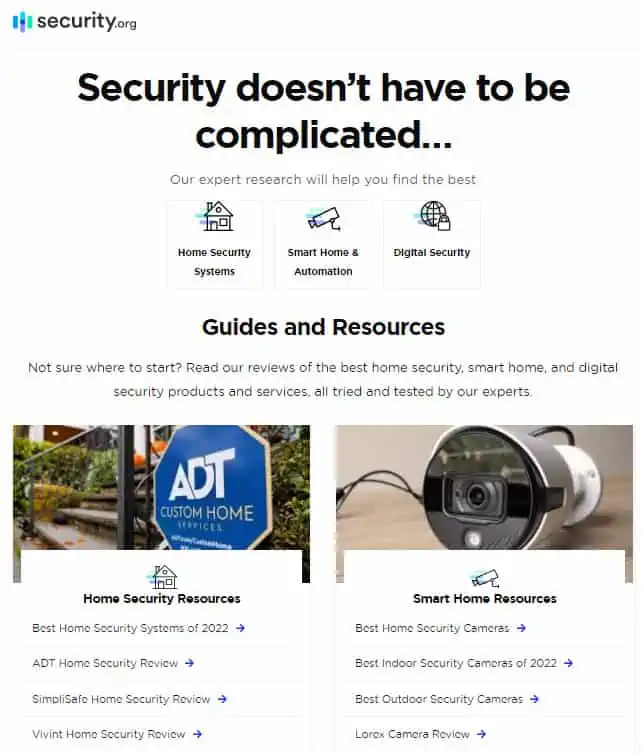
2. Makeup Alley
This blog is focused on reviewing beauty products.
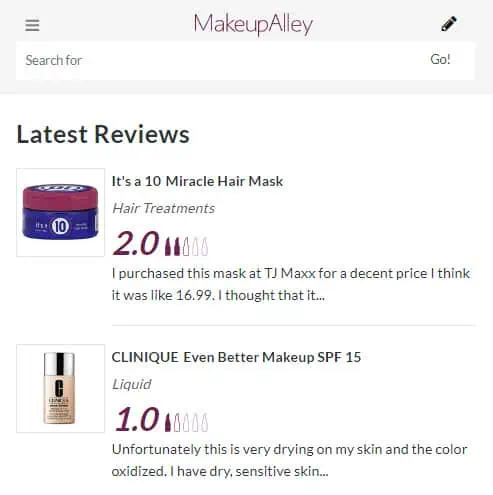
3. The Sweet Setup
This blog helps people find the best apps and tools for their Macs, iPhones, and iPads. They make money through affiliate marketing and advertising.
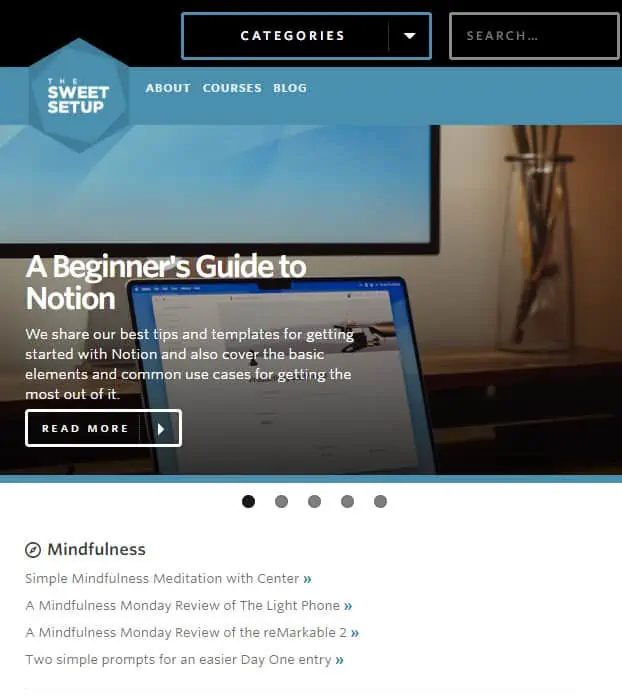
4. Top Ten Reviews
This blog has reviews of the top ten items in almost every product category under the sun.

5. Wire Cutter
This is a section of the New York Times that focuses on reviewing products and making money through affiliate marketing. They review a wide range of products from technology to home goods.

Check if Your Niche Is Seasonal
One thing to keep in mind as you’re choosing your niche is whether or not it’s seasonal. A seasonal niche is only popular at certain times of the year. For example, a blog about Skiing would only be popular during the winter.
If you choose a seasonal niche, that’s okay. Just be aware that you’ll need to make adjustments to your blogging and monetization strategies during the off-season.
One way to check if your niche is seasonal is by using Google Trends. Just enter your keyword into Google Trends and see how popular it is throughout the year.
For example, if we enter the keyword “skiing” into Google Trends, we can see that it’s most popular during the winter months:

3. Pick & Register a Blog Domain Name
Once you have chosen your niche, it is time to brainstorm a few names for your review blog.
We recommend you keep your review blog’s name to two words (Example: Makeup Alley). One of the two words should be a keyword from your niche. The other word can be something that makes your website brandable. For example, our blog teaches people how to make passive income, so we have named it Passive Book.
Do not use the words review in your blog name because it will make your website look spammy making it difficult to brand.
Use a Business Name Generator to brainstorm the name of your blog.
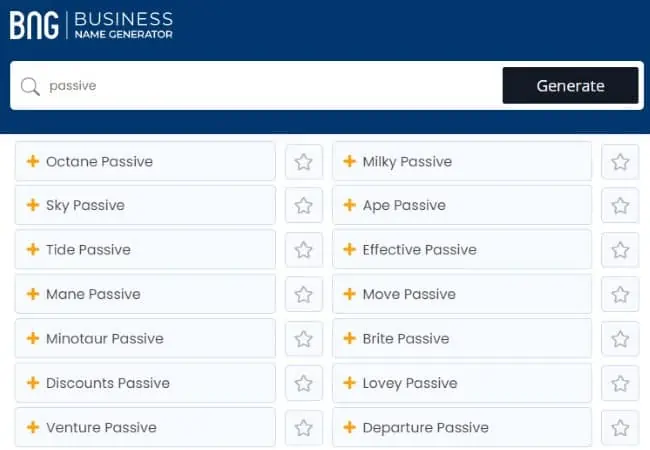
You can also use your own name for your blog. But if you ever plan to sell your website in the future, it is much more difficult to transfer your brand to the buyer when it is your name.
Check Domain Name Availability
After you have brainstormed a few names for your review blog, you should check if the .com domain name is available.
A domain name is the web address of your blog. It’s what people type into their browsers to find your website. It is usually your blog name followed by an extension like .com.
You must check if both the .com domain name and the social media handles are available. You can use Namechk to check the availability of both your domain name and social media handles.
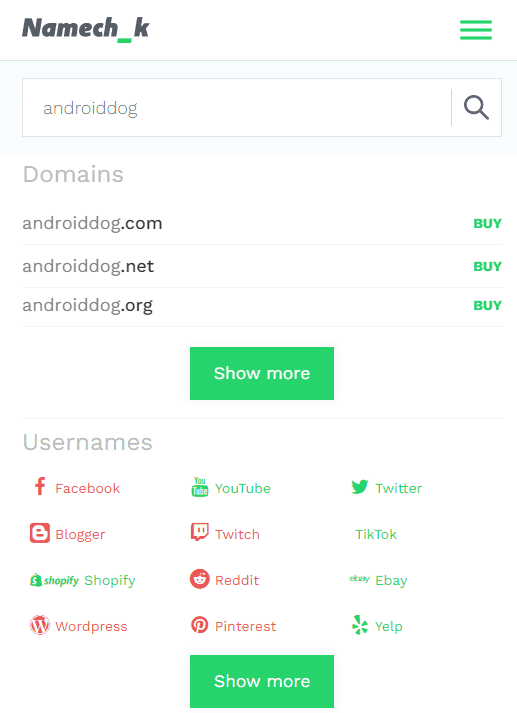
Here are a few things to keep in mind when selecting a domain name:
- Choose a .com domain name. 86% of the internet uses .com, so your visitors are likely to try visiting your blog by typing .com. Avoid other extensions like .net or .org.
- Don’t include hyphens and numbers.
- Do not use words with multiple spellings (for example colour vs color).
- Shorter domain names are better. Try to keep it under 12 characters.
- Spelling & Pronunciation should be easy and intuitive.
- It should be easy to remember.
- Avoid words that can be misread together. For example, therapistjohn.com can be read as Therapist John or The Rapist John.
- Make sure it’s not trademarked or copyrighted by someone else. The AI writing software Jarvis.ai had to rebrand to Jasper.ai because Marvel sued them for the Iron Man reference. Lawsuits will happen once your blog is established.

Register a Domain Name
Once you decide your domain name it is time to register it.
You should register your domain with NameCheap because you will get domain privacy for free. Other providers charge $12 per year for domain privacy. Without domain privacy, your name, home & email address will be accessible to the public.
Step 1: Go to NameCheap. Enter your domain name with the .com extension.
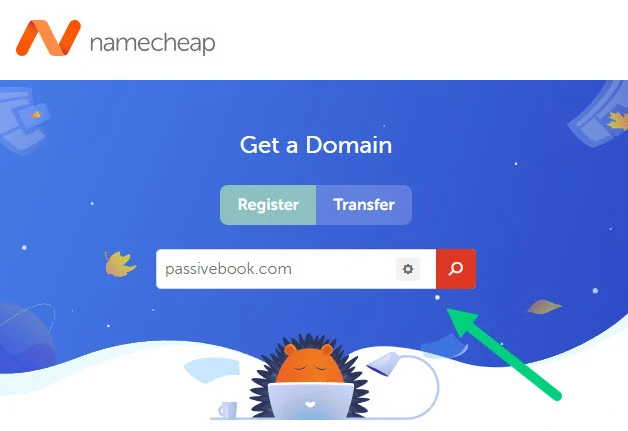
Step 2: Select the .com extension and click the Add to Cart button.
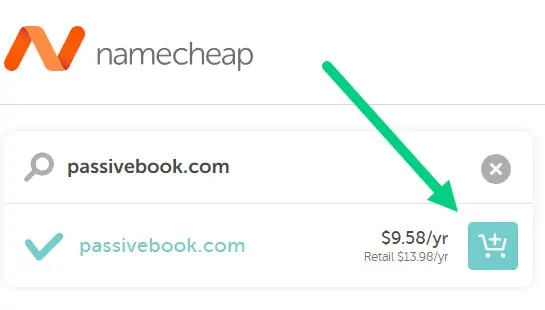
Step 3: After adding the domain to the cart, click on the Checkout button.

Step 4: Enable Domain Privacy that comes for free along with auto-renew. You don’t need any other paid addon.

Step 5: Click on Confirm Order. Pay to complete your purchase.
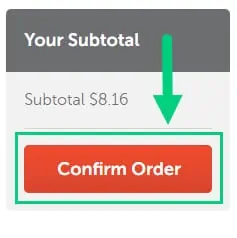
Step 6: Log in to Namecheap and click on Domain List ❶ in the left sidebar and then click Manage ❷ next to the domain you just purchased.
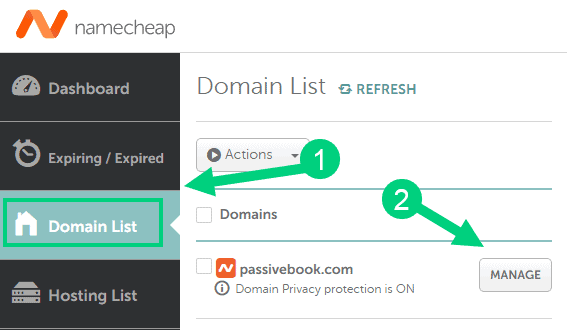
Step 7: Under the Nameservers section, select “Custom DNS” from the dropdown ❶. Then enter the following two nameservers ❷ ns1.bluehost.com and ns2.bluehost.com as shown in the image. Then click the green tick ❸ to save. If you use a hosting provider other than Bluehost, enter their nameserver values in this step instead.
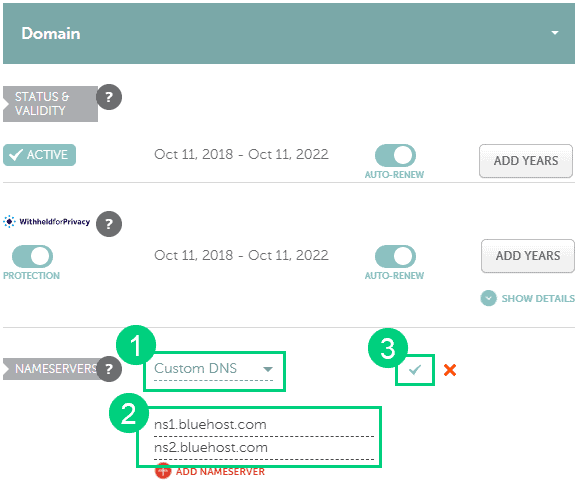
Can I get a free domain name?
Your web hosting provider might give you a free domain name for one year but they charge $12 for domain privacy which is free in Namecheap. From the second year, you will pay for both the domain and privacy which will cost you more than $20+. So it is cheaper to just register your domain with Namecheap from the beginning. Also using different companies for web hosting and domain registration will allow you to easily switch your blog host later without transferring domains.
Can I change the name of my blog later?
You will lose your search engine rankings if you change your blog’s name once it gets links from other websites. It will take as long as a year or more for you to regain the lost traffic. It is possible to mitigate problems by having proper redirects. But you will have to renew both your old and new domains every year. So try to avoid changing your blog’s name once it is established.
4. Setup WordPress
Now that you have registered your domain name, it’s time to set up WordPress.
WordPress is a content management system (CMS) that allows you to create a website or blog without any coding knowledge. Once you set up WordPress, you can easily create and publish blog content with images, videos, and more.
Why Choose WordPress.org?
There are many blogging platforms but the self-hosted wordpress.org powers 70% of blogs on the internet. 42% of all websites on the internet use WordPress.

We recommend you use WordPress.org for your blog because:
- It’s free to use in the hosting of your choice.
- You own your content and can do whatever you want with it.
- There are no limits to how much traffic your website can get.
- It’s easy to use with a user-friendly interface.
- You can find WordPress themes and plugins to customize your blog.
- It’s SEO friendly.
WordPress.org vs WordPress.com
There are two WordPress platforms: WordPress.com and WordPress.org.
Most people get confused between the two because they are both owned by the same company, Automattic.
Here’s how they differ:
WordPress.com is a free blogging platform while WordPress.org is a self-hosted platform which means you need to pay for hosting.
WordPress.com has limitations like not being able to install plugins and you can’t run ads. You cant add a domain name unless you upgrade to their more expensive paid plan.
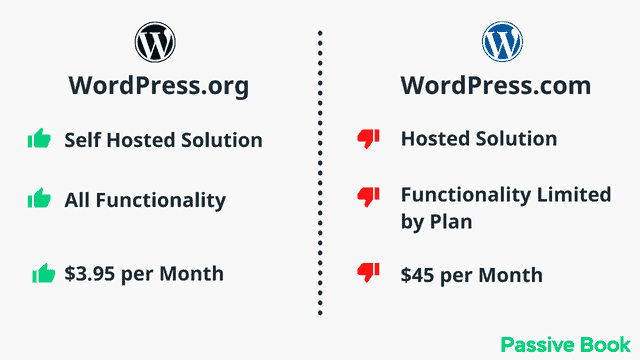
WordPress.org gives you full control of your blog. You can install themes and plugins, customize your website, and make money with ads and affiliate links. It is also a much cheaper option for bloggers interested in making money.
Why Avoid Free Blogging Platforms
There are many free blogging platforms like Blogger and Tumblr. However, we recommend you don’t start your blog on a free platform because:
- It’s harder to grow your traffic because these platforms are not favored by search engines.
- You can’t monetize a free blog. If you want to make money from your blog, you need to be self-hosted on WordPress.org.
- You don’t own your content. The platform can delete your blog at any time without warning.

How much does it cost to start a review website?

It will cost you $2.95 per month to host your WordPress review blog in Bluehost. A domain will cost you $12/year. So that is a total of $4.2 per month, which is less than the price of Netflix for all the unlimited features that a self-hosted WordPress blog has to offer.
What to do if you already have a free blog?
Migrating to WordPress is a very easy process using free import plugins. All you need to do is install the plugin, enter your old and new blog URLs, and click migrate.
Install WordPress in Hosting
For you to use WordPress, you need a web server.
Blog hosting is a service that provides you with a web server to host your blog on. This is different than your domain name, which is the address of your website.
For example, your domain name is www.example.com and your web hosting is the server that stores all the files for your website and makes it accessible to the world wide web. If your domain name is the address of your business, then your web hosting is the storefront and office space.
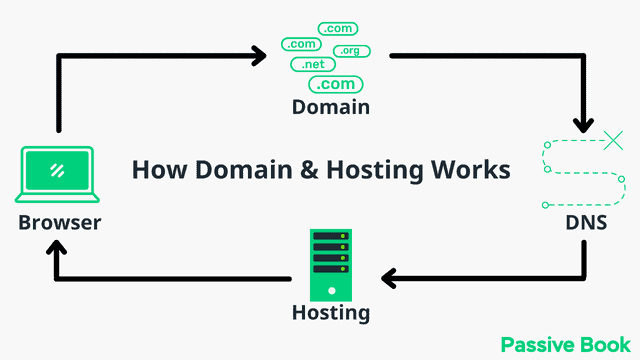
For this guide, we will use BlueHost as our web host. It is a cheap hosting that is extremely easy for beginners to set up. If you use any other web host, the steps will be the same but the user interface may be slightly different.
1. Go to BlueHost using this link to get a special discount. Select WordPress > WordPress Hosting from the top menu.
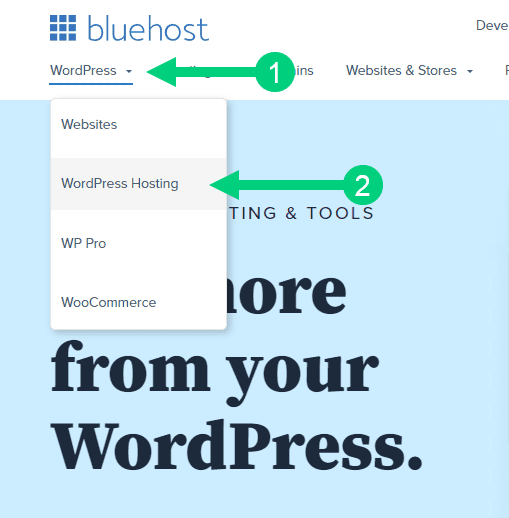
2. Click on the button you see on this page and you will be taken to the pricing section.

3. Select the Basic Plan. You can upgrade to a different hosting plan as you grow.
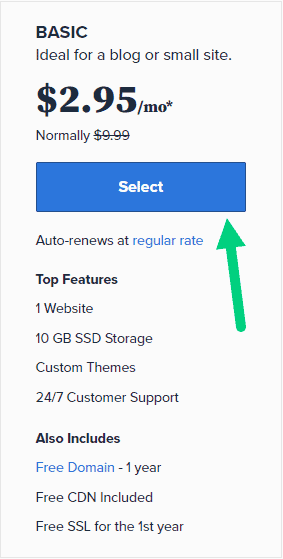
4. If you already have a domain name that you purchased with Namecheap you can put that in the “Use a domain you own” ❶ section. If you don’t have a domain name yet, choose the “Create a New Domain” ❷ to purchase a new domain.
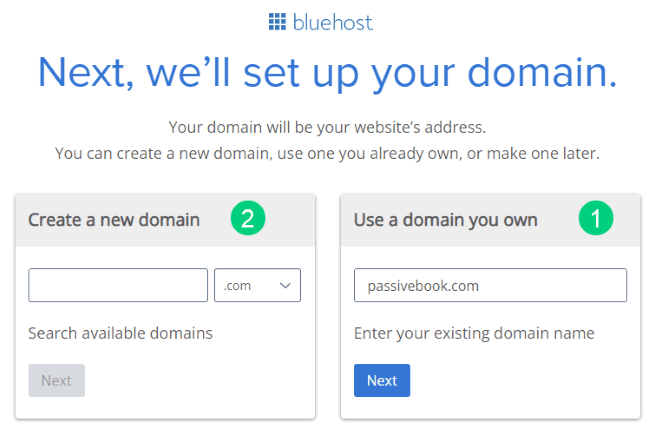
5. In the next screen, enter your information. Uncheck all package extras. If you purchase your domain through Bluehost instead of Namecheap, you may want to enable Domain Privacy. You won’t see the Domain Privacy option if you bought your domain through Namecheap. Namecheap will give you this Domain Privacy for free.
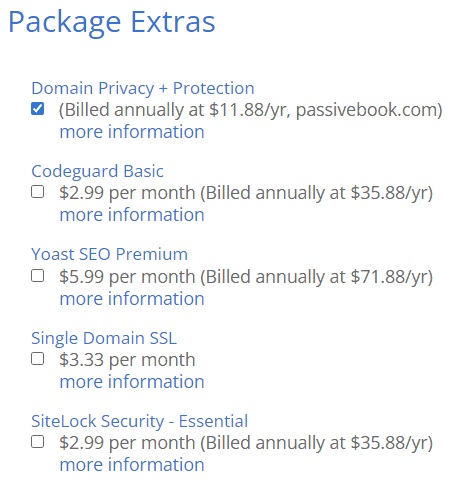
6. Once you have successfully paid, you will be prompted to set a password. Click on the “Create your Password” button.
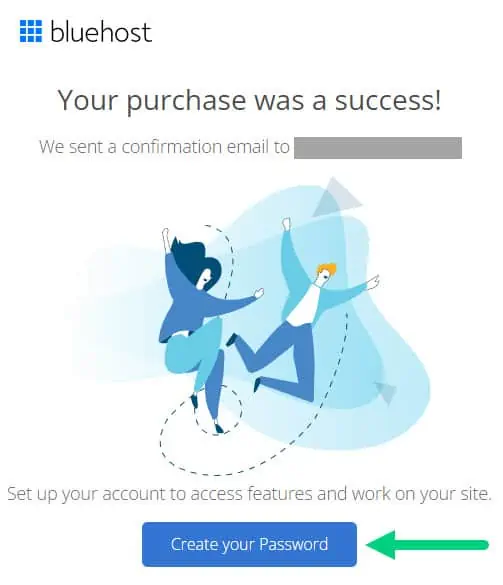
7. Enter your password and create your account. If you lose this password, you can reset it.

8. After you set your password, log in to Bluehost.
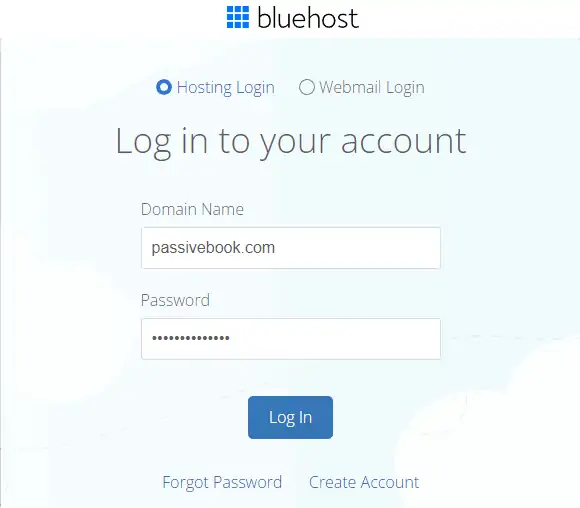
9. Click on the Create your website button on the following screen. This will start a Bluehost Wizard, just click Skip this step wherever possible.

10. On the following page, click “No help needed” or “Skip this step”. We don’t want Bluehost to limit our customization options.
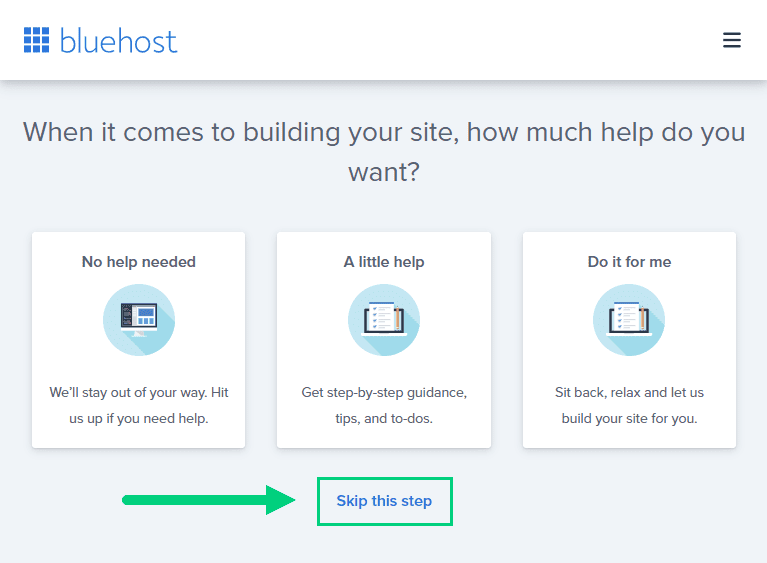
11. On the next page, you will be asked about the purpose of your website. You can choose from any of the available options.
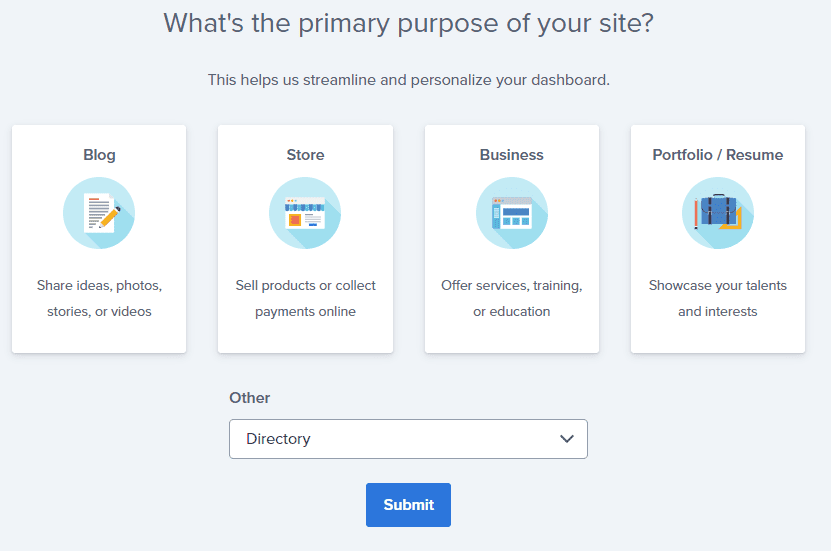
12. On the next page, click Skip this step.

13. On the following page, enter the blog’s name and tagline. You can change this later so feel free to click “Skip this step” or enter something as a placeholder and click Continue.
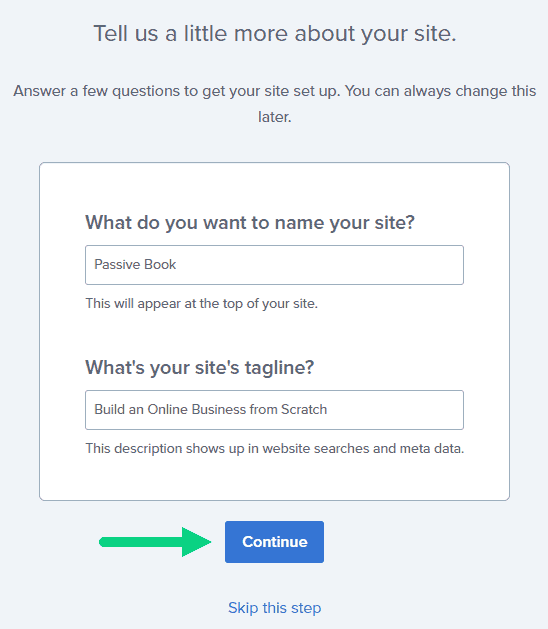
14. Finally you will be asked how you want to build your website. Choose “Limitless customization” to have all the options.
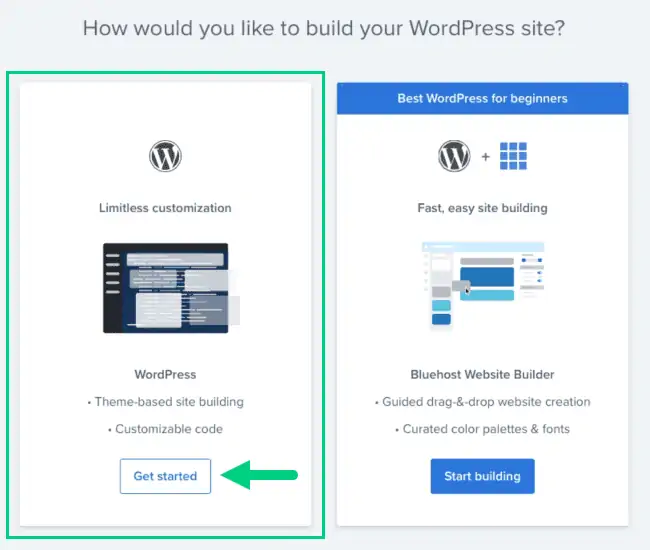
15. You can see your blog by going to yourdomain.com. Go to the Bluehost dashboard and click on the My Sites tab ❶ in the left sidebar and click on the “Manage site” button ❷.

16. Your WordPress site has separate login credentials different from the ones you use to log into Bluehost. You can use this to log in to the WordPress dashboard directly without logging into Bluehost. To get this:
❶ Click on Users on top.
❷ You will be able to see your username and email that you can use to log in to WordPress.
❸ If you click on the three dots you will see the option to Reset your password. ❹
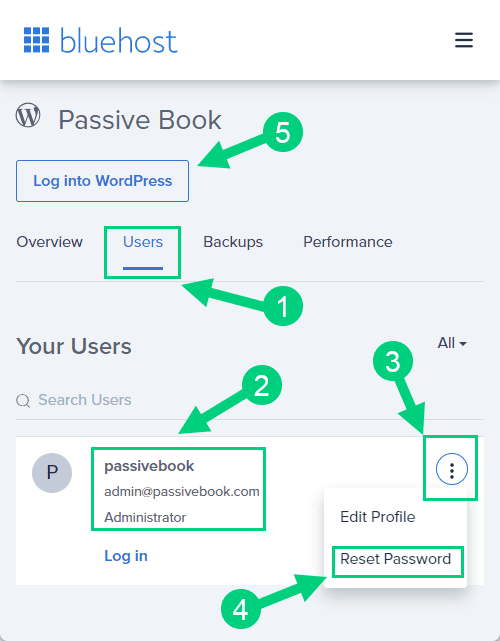
You can log into WordPress from the Bluehost dashboard by clicking the Log in to WordPress button ❺. But it is not recommended you rely on this as your primary login method because you will get locked out of your site if you ever change hosting providers.
17. You will be taken to the WordPress dashboard where you can reset your password ❶. If you don’t like the username Bluehost created for you, you can Add a New User ❷.

18. If you are adding a new user make sure you specify the user role as Administrator ❶. You can log in as the new user and safely delete the default user created by Bluehost.
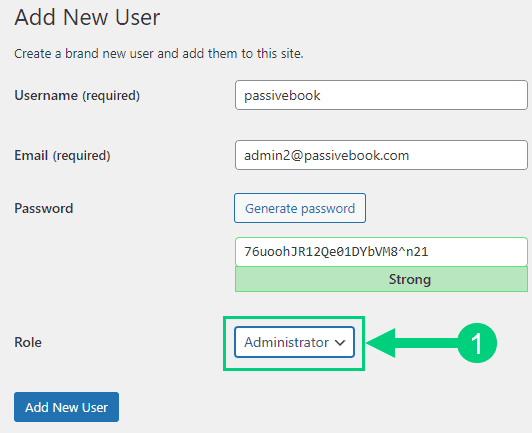
Congratulations! You have successfully set up WordPress.
Configure WordPress
Now that you have the basic version of WordPress installed, it is time to customize it to make it look and feel the way you want.
Login to WordPress Dashboard
Visit yourdomain.com/wp-admin to access the WordPress dashboard.

The WordPress Dashboard is the control center for your WordPress site. It’s where you go to add new posts, edit existing posts, manage your pages, add new users, and more.
Use the Email and Password you provided during installation to log in to your WordPress dashboard. If you don’t have a password, use the “Lost your password?” to generate a new password.
Install WP Themes
A WordPress theme is a collection of files that determine the look and feel of your WordPress site.
When you install WordPress, you have the option to choose from thousands of free and premium themes.
A theme can control the layout, colors, fonts, and overall style of your site.
It’s important to choose a mobile-responsive theme, which means it will automatically adjust to different screen sizes.
Your new WordPress blog will be installed with a default blog theme that doesn’t look very great.
To install a new WordPress Theme:
Go to Appearance > Themes > Add New in your WordPress dashboard.
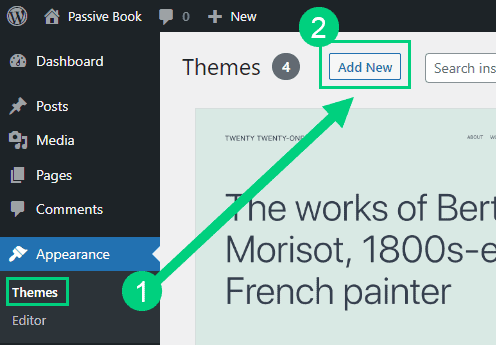
Use the search to find a theme that you like ❶. Before you install the theme, you can see a demo of the theme and learn about its features from the preview screen ❷. If you like the theme, you can install it by clicking the install button ❸. You can also upload a theme from a file on your computer ❹.
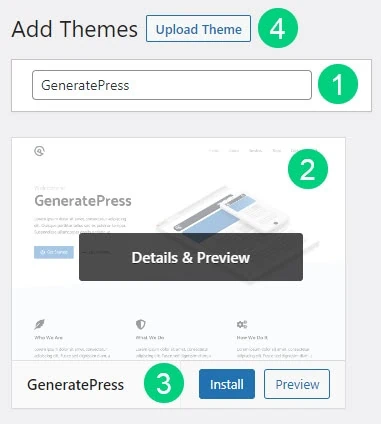
Once installed, click the Activate button to enable the theme.
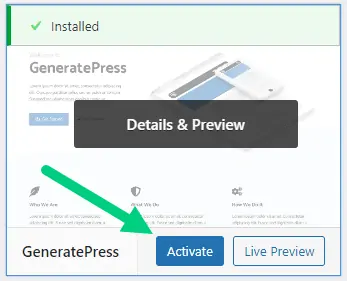
Although you can use a free theme (there are thousands of free themes available), we recommend using a premium theme.
Premium themes not only reduce your website’s load time but also help you customize your website to your heart’s desire.
Here are the premium themes we recommend:
There are also several custom-made review blog themes. These themes tend to be bloated with poor code which will slow down the performance of your website. We suggest getting one of our recommended themes for a fast website with unlimited customization possibilities.
Install WP Plugins
A WordPress plugin is a software application that adds features or functionality to WordPress. There are over 50,000 plugins in the WordPress plugin repository, and many more are available from third-party sources.
Too many wordpress plugins can slow down your blog site. So before you install new plugins, it will be worth clearing out any existing plugins that your hosting provider installed by default.
Plugins first need to be deactivated before they can be deleted.
❶ Go to WP Admin > Plugins > Installed Plugins
❷ Click on the checkbox to select all plugins.
❸ Select Deactivate from the drop-down.
❹ Click Apply.
❺ Repeat the above steps but select “Delete” instead of “Deactivate” from the dropdown in ❸ to delete all the deactivated plugins.
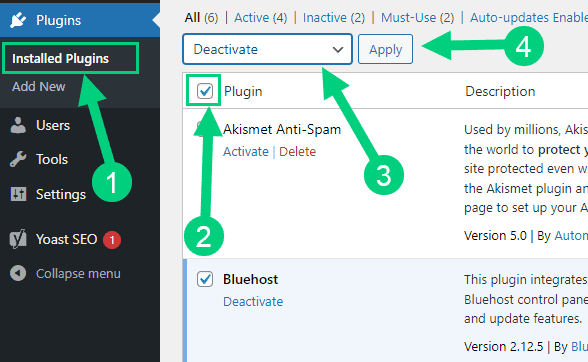
To install new plugins go to the WP Admin > Plugins > Add New.

On the plugins page:
❶ Search for the plugin you want in the search bar
❷ Click Install Now. Once you install the plugin, you must also activate the plugin for it to be enabled.
❸ If you are installing a paid plugin you can upload the plugin instead.

There are many different review blog plugins that you can install, but here are the ones which we recommend:
Backup Plugin: A WordPress backup plugin creates backups of your WordPress site. A backup plugin can save you from losing all your data in the event of a disaster, such as a hacked website or server crash.
Backup plugins are important because they automate the process of creating backups, so you don’t have to remember to do it yourself.
Recommended Plugin: WPVivid (paid) or UpdraftPlus (free).
SEO Plugin: A WordPress SEO plugin helps you optimize your website for search engines.
Recommended Plugin: RankMath (paid).
Google Analytics Plugin: A WordPress Google Analytics Plugin helps you collect and track data about how people use your website. With this information, you can make improvements to your website that will help you attract more visitors.
Recommended Plugin: RankMath (paid) or GA Google Analytics (free).
Cache Plugin: A WordPress Cache Plugin stores copies of your website’s pages and posts in a cache, or temporary storage area. This allows your website to serve pages faster to visitors because the pages don’t have to be generated each time they are requested.
Recommended Plugin: WP Rocket (paid).
Page Builder Plugin: A WordPress Page Builder Plugin lets you build pages on your WordPress site using a drag and drop interface. With a Page Builder Plugin, you can create complex pages without needing any coding knowledge.
Recommended Plugin: Thrive Architect (paid).
Security Plugin: A WordPress Security Plugin helps you protect your website from hackers and malware.
Recommended Plugin: Wordfence (free).
Social Media Plugin: A WordPress Social Share Plugin helps readers share your website’s content on social media. With a social share plugin, you can easily add social media buttons to your website’s pages and posts, which will allow visitors to share your content with their friends and followers.
Recommended Plugin: Easy Social Share Buttons (paid).
Email List & Lead Generation Plugin: A WordPress Email Opt-in Form Plugin helps you collect email addresses from your website’s visitors. With an email opt-in form plugin, you can add a form to your website that will allow visitors to subscribe to your mailing list. This will allow you to contact them with new blog posts and product announcements.
Recommended Plugin: Thrive Leads (paid).
Customize WordPress
Once you have installed your theme and plugins, it is time to customize the wordpress blog platform:
Change Colors, Fonts & Spacing
You can set the font, colors, and spacing by going to Appearance > Customize in your WordPress dashboard. Premium themes like GeneratePress allow you to customize every aspect of your blog.
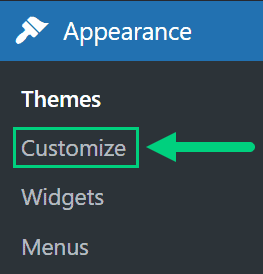
Check out our Blog Fonts & Typography guide to choose the right font and typography settings for your blog.
Add Your Logo
Get a logo designed for your blog from Fiverr. Then set the logo of your blog by going to Appearance > Customize in your WordPress dashboard. A logo is not required for a successful blog but it can definitely help appeal to your target audience.

Change Favicon
Favicon is the image that appears in the browser tab and bookmarks. Set the Favicon from the Appearance > Customize section of the WordPress dashboard.

Create Menus
The header and the footer menu can be set from the Appearance > Menus in your WordPress blog dashboard.

You can nest menu items so that it appears as a dropdown menu ❶. You can use the menu as your primary or secondary navigation menu ❷. Don’t forget to save your menu ❸.
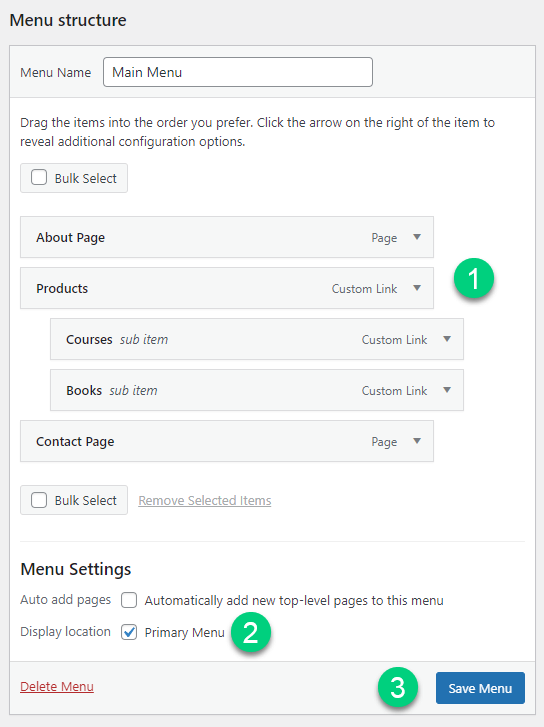
Create Widgets
If you have a sidebar, you can add widgets to it. Go to Appearance > Widgets in your WordPress admin dashboard.
Check out the list of the most useful Blog Widgets and how to add them to your blog.
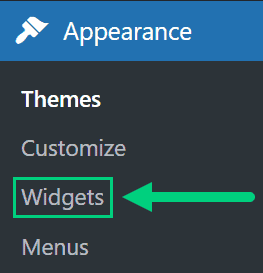
Set Title & Tag Line
The next step is to change your General Settings. Go to Settings > General in the WordPress Admin area.
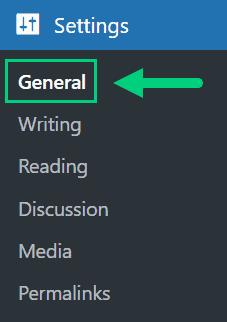
You can set your Site Title, Tagline, and Time Zone from this screen.
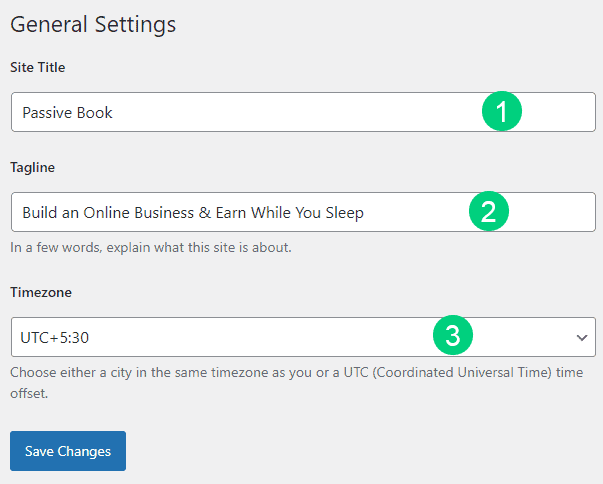
Set Permalinks
The ideal URL structure for SEO is yourdomain.com/sample-post. Set your permalink structure by going to Settings > Permalinks in your WordPress blog dashboard.
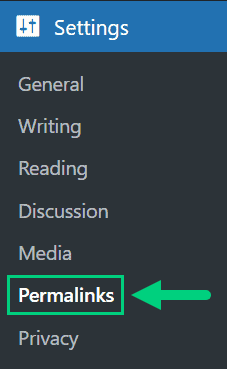
Select the “Post name” radio button and save changes.
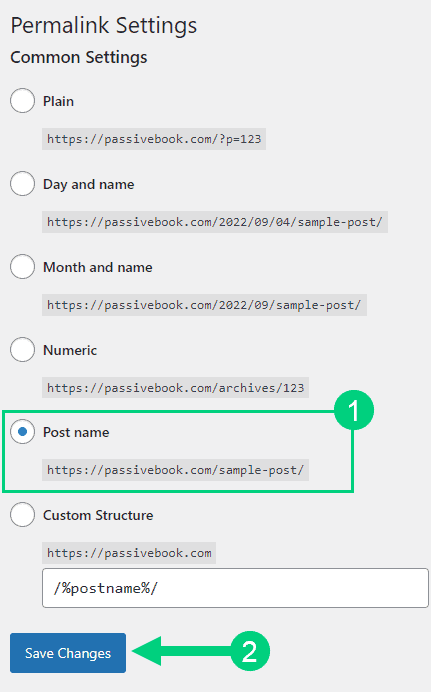
Enable Search Visibility
Chances are you want your blog to show up on Google so people can find you. Go to Settings > Reading in your WordPress dashboard.

To get search engine traffic, ensure the checkbox “Disable search engines from indexing this site” is Unchecked. You can find this option in Settings > Reading. Most of the time this should be unchecked by default but if it is not, then uncheck it to ensure your site gets traffic from search engines.
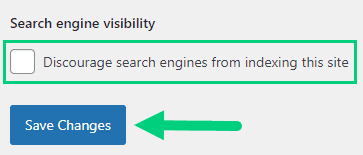
Adjust Comment Settings
Next, you will want to change the Discussion Setting (aka Comments). Go to Settings > Discussion in your WordPress admin area.
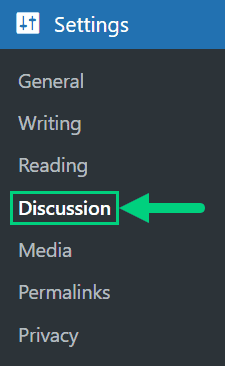
❶ You may want to enable or disable comments on this page. You can also disable pingbacks and enable comment moderation.
❷ You can also set comment approval settings.

If you want to design your blog further, check out our dedicated guide on blog design which has all our best blog design recommendations.
Create Static Pages
There are a few essential pages that you need to create for your review blog before you can start blogging.
Use pages in WordPress to add static content. Go to WP Dashboard > Pages > Add New.
- Write the headline of your content.
- Populate the body content
- Click the publish button.
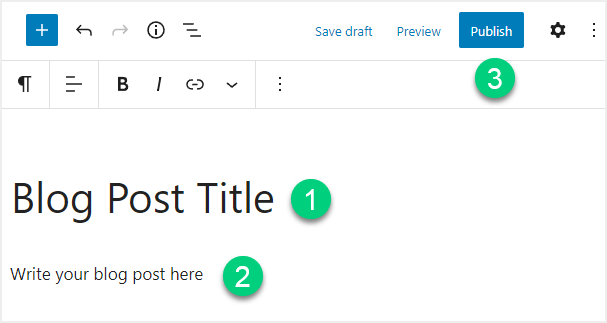
You may want to create the following pages:
Home Page
Your home page is the page that your visitors see when they first visit your website. It is important to make sure that your home page is attractive and informative so that visitors will stay on your site and explore more of what you have to offer.

You can create a professional home page for your review blog using a page builder like Thrive Architect.
About Page
An about page is a page on your website that tells visitors who you are and what you do. It is important to have an about page because it helps visitors get to know you and builds trust.
Your About page should include:
- A brief description of who you are
- What you do
- Why do you do it
- What you offer
- A call to action (CTA)

Contact Page
A contact page is a page on your website that provides visitors with a way to get in touch with you. It is important to have a contact page so that visitors can ask questions, give feedback, or request more information about your products or services.
Your contact page should include:
- A form that visitors can fill out to send you a message
- Your email address
- Your phone number
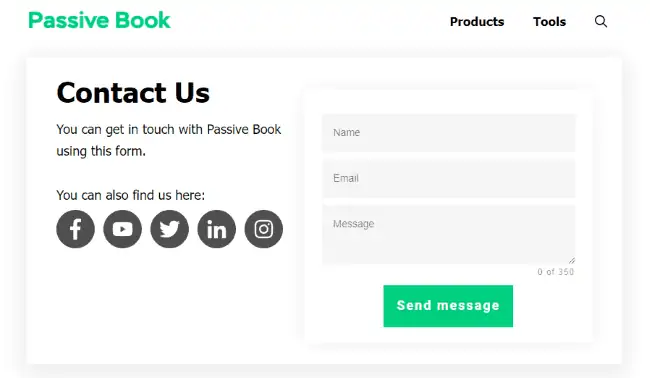
Use contact form plugins like Fluent Forms to create the form on your contact page.
Privacy Policy
A privacy policy page is a page on your website that tells visitors how you collect, use, and protect their personal information. It is important to have a privacy policy page because it helps visitors understand how their information will be used, and it builds trust.
WordPress generates its own privacy policy for you. But you can also use a tool like Termly to generate your own privacy policy.
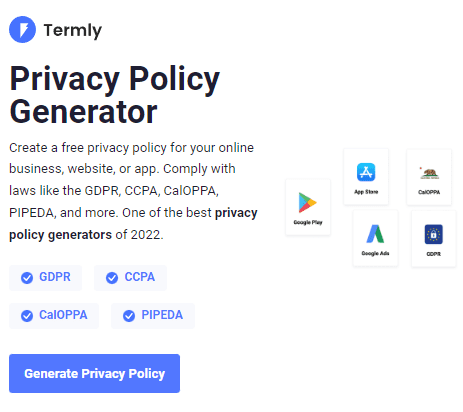
Terms of Service
A terms of service page is a page on your website that tells visitors how they can use your website, products, and services. It is important to have a terms of service page because it helps visitors understand what they can and cannot do on your site.
Use a terms & conditions generator like Termly to create it.
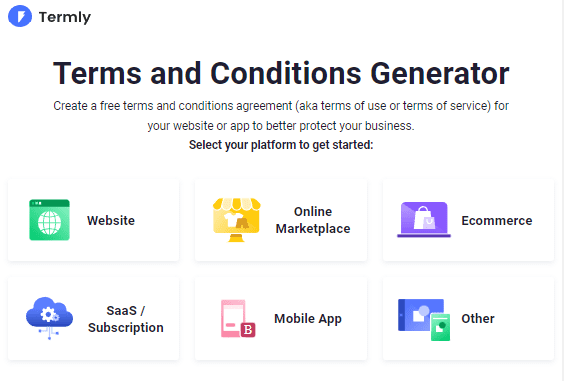
5. Write & Publish Blog Posts
Now that you have your review blog setup, it’s time to write and publish your first blog post. We have an in-depth guide on How to Write A Blog Post where we take you through the process step-by-step. Here we will go over specific tips to write product review blog posts.
1. Brainstorm Topics
You should brainstorm 100 topic ideas for your review blog. This will ensure that you always have content to write about in your review blog.
The goal is to find topics for review posts that your target audience is already searching for in Google. The type of review content you write on your review blog will depend on your specific niche.
Here are a few review blog post ideas, you can potentially cover in your review blog:
- Single Product Reviews
- X vs Y Comparison
- Best X for Y
- Product Roundups
- How-To Guides
There are a few ways to brainstorm specific content:
Look at Competitors
You need to find a product to review on your blog. A great way to come up with blog post ideas for your review blog is to look at how other people are blogging in your niche.
A good place to start is by looking at how the bloggers you admire write about their topics of expertise.
You can find your competitors by googling a keyword related to your topic and scrolling through the results.
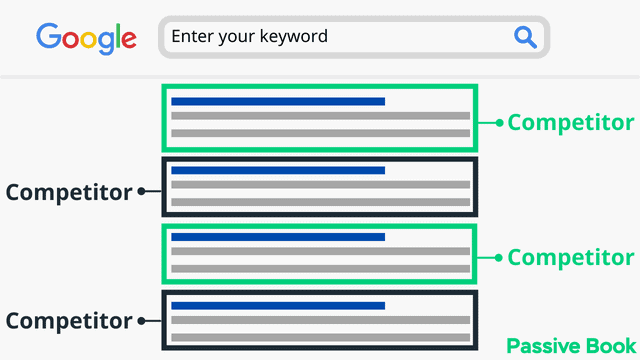
Do Keyword Research
One great way to come up with blog post ideas for your review blog is to do keyword research.
You can use a tool like KeywordTool.io to help you find keywords related to your topic that you may not have thought of before.
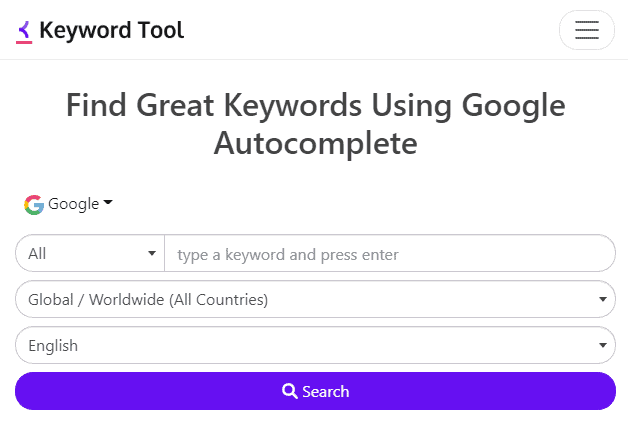
This will help you come up with content ideas that your audience is searching for in Google.
2. Create an Editorial Calendar
An editorial calendar is a tool that helps you plan, organize, and track your content.
It can be as simple as a Google Doc or an Excel spreadsheet.
Your editorial calendar should include:
- The date you plan to publish
- The title
- A brief description of the content
- The keywords you plan to target
- The author
Download Content Calendar Template

Steal our exclusive content calendar template. Have it delivered directly to your inbox:
3. Write a Blog Post
Once you have your editorial calendar set up, it’s time to start writing your blog posts.
Write 5x Faster with AI
You can write your new blog post at 5x speed using the AI writing software Jasper. I was able to write over a hundred blog articles in 3 months using Jasper. This blog article you are reading right now was written with the help of Jasper. AI will not only help you write blog posts fast but also with higher quality.
Jasper can write plagiarism-free blog content, articles, social media content, emails, and ad copy. All you have to do is provide a few inputs on what you want and Jasper will do all the hard work of creating the blog content for you. No more writer’s block.
Check out the video below to see Jasper in action:
Try Jasper for free using the links on this page and get 10,000 bonus credits you can use to start writing your first articles.
Once you sign up for Jasper I recommend you spend some time going through the tutorial videos in the Jasper Bootcamp to truly unlock the power of this amazing software.
Check out our guide on How to Write a Blog Post Fast in 15 mins Without Losing Quality for more tips to write fast.
Writing Reviews
One of the most popular types of content in review blogs are reviews.
A review is a piece of content that gives your opinion on a product or service.
If you’re going to write a review, it’s important, to be honest and transparent. You should also disclose any affiliate relationships you have with the company you’re reviewing.
Example:
- Review of the latest iPhone model
- Review of Atomic Habits by James Clear
- Review of Canon EOS R6

Here are a few tips for writing reviews:
- Use a rating system to rate the product or service you’re reviewing
- Include the pros and cons of the product or service
- Be honest about your experience with the product or service
- Disclose any affiliate relationships you have
Writing X vs Y Comparisons
A product comparison is a piece of content that compares two products or services. Comparisons are helpful for visitors because they can see the differences between two products or services side by side.
Example:
- iPhone 12 Pro vs Samsung Galaxy S21
- Peloton vs NordicTrack
- Netflix vs Hulu

Here are a few tips for writing comparisons:
- Include a table with the features of each product or service
- Be fair and balanced in your comparisons
- Don’t compare apples to oranges
- Disclose any affiliate relationships you have
Writing Product Roundups
A product roundup is a piece of content that includes a list of products or services. Product roundups are helpful for visitors because they can see a bunch of different options in one place.
Example:
- Round up of the best laptops under $1000
- Round up of the top 10 skincare products for sensitive skin
- Round up of the best home workout equipment

Here are a few tips for writing product roundups:
- Include a list of products or services with links to each one
- Write a brief description of each product or service
- Disclose any affiliate relationships you have
Writing How-To Guides
A how-to guide is a piece of content that teaches the reader how to do something. How-to guides are helpful for visitors because they can learn how to do something new.
Example:
- How to create a successful social media strategy for your business
- How to make your own homemade cleaning products
- How to take better photos with your smartphone.

Here are a few tips for writing how-to guides:
- Include step-by-step instructions on how to do something
- Use images or videos to help illustrate the steps
- Write in a clear and concise manner
Outsource Writing
If you don’t have the time or energy to write all of the content for your blog yourself, you can outsource it.
There are several sites where you can find freelance writers, such as:

When outsourcing content, be sure to give clear instructions on what you want the writer to cover.
You should also provide any relevant links or resources that they can use.
And finally, be sure to edit the article before you publish it on your blog.
4. Add Images
Adding images to your blog posts is important because it can help break up the text and make your post more visually appealing.
It’s also a good idea to add alt text to your images so that Google can index them and people who are using screen readers can still understand your content.
The best images for your blog posts are the ones you take yourself. This is because you have complete control over the content and how it is presented. You can choose the angle, the lighting, and how much Photoshop or other editing software you want to use.
If you don’t have the time or energy to take your own photos, you can use stock images.
There are several sites where you can find free stock images, such as:
Free Options: Pixabay, Pexels, Upsplash
Paid Options: Deposit Photos, Shutterstock, iStock, Getty Images, 123rf.
When using free stock images, be sure to give credit to the photographer. You can do this by adding a watermark or including a link to the image source. You don’t have to do this with paid stock photos.
You can use Canva to create images for your blog posts. Canva is a free online design platform that you can use to create images for social media, ads, presentations, and more.
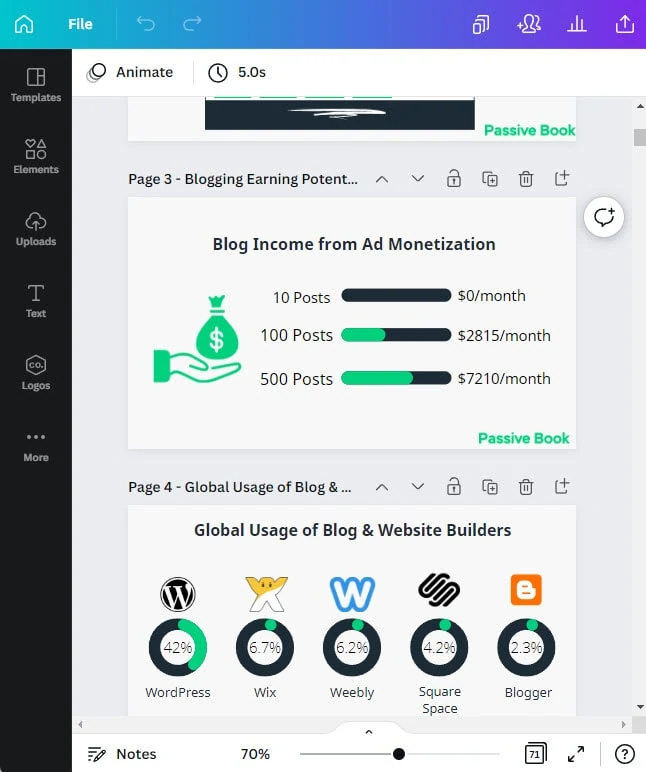
If you’re looking for high-quality images to use in your blog posts, then you should upgrade to Canva Pro. The free library of stock images is limited, but the library of paid images is huge and it’s constantly updated. Plus, you get access to exclusive templates and tools that aren’t available to free users.
6. Promote Your Review Blog
One of the most important things you can do to promote your blog is to create great content.
If you write helpful, informative, and engaging blog posts, then people will naturally want to share your content with their friends and followers.
In addition to creating great content, there are a number of other things you can do to promote your blog to get blog traffic, such as:
Search Engine Optimization (SEO)
SEO, or search engine optimization, is the process of optimizing your blog posts so that they rank higher in the search engine results page (SERP).
This means that your posts will be more likely to show up when someone searches for a topic related to your blog.
There are many things you can do to optimize your blog posts for SEO, such as:
- Use keyword-rich titles
- Write keyword-rich descriptions
- Use keyword-rich headings and subheadings
- Use images and alt text
- Add social media tags
- Add metadata
Many factors go into SEO, and it can be a bit confusing to figure out where to start. You can master the more advanced SEO tactics by checking out our SEO Resources.

You can ensure you get the basics of SEO right, by completing the recommendations given by the RankMath plugin.
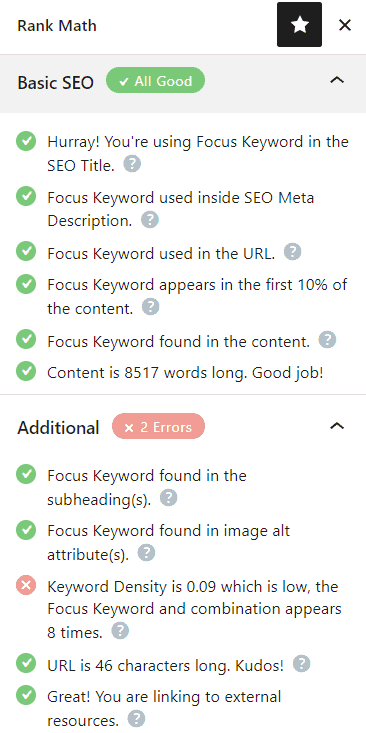
Email Marketing
Email marketing is a great way to promote your blog because you can reach a large audience with very little effort.
When you have an email list, you own the relationship with your subscribers. This means that you don’t have to rely on social media algorithms or search engine rankings to reach your audience.
You can simply send them an email whenever you have something new to share.

To start building your email list, add an opt-in form to your blog. An opt-in form is a form where people can sign up to receive emails from you.
You can then connect your opt-in form to an email marketing service to automatically send emails when someone subscribes to your list.
You can use the Thrive Leads plugin to build opt-in forms to collect email addresses. You can then connect the opt-in form to an email marketing service like Active Campaign to send out the emails.
Check out our Email Marketing resources to learn more.
Social Media Marketing
Social media marketing is another great way to promote your blog.
When you share your blog posts on social media, you can reach a large audience with very little effort.
Plus, social media is a great way to build relationships with potential and current readers.
To get started with social media marketing, simply create accounts on various social media platforms and start sharing your content.
Here are some of the most popular social media platforms:
As you start sharing your content on social media, be sure to use images and hashtags to make your posts more engaging. You should also take some time to interact with other users on the platform.
For example, you can retweet other users’ tweets, comment on other user’s posts, and join social media groups.
Guest blogging
Guest blogging is a great way to promote your blog because it allows you to reach a new audience.
When you guest blog, you write a blog post for another person’s blog. This gives you exposure to their audience, which can be a great way to attract new readers to your own blog.
To get started with guest blogging, simply find blogs in your niche that accept guest posts and pitch them an article idea.
Be sure to read the submission guidelines before pitching an article idea and make sure that your article is high quality and well-written.
You can link back to your blog from the guest post and the author bio.

7. Monetize & Make Money
Once you have a decent amount of traffic coming to your blog, you can start monetizing it.
There are many ways you can make money from your blog, such as:
Affiliate Marketing
Affiliate marketing is a great way to make money from your review blog because you can make a commission on products that you recommend.
For example, if you have a review blog about gardening, you could add affiliate links to the gardening products and tools that you recommend. If someone clicks on your affiliate link and buys the product, you would then earn a commission.
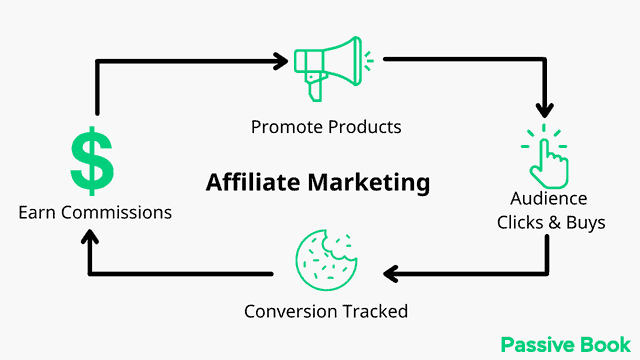
To get started with affiliate marketing, simply sign up for affiliate programs for products that you recommend. The most popular program is the Amazon Affiliate Program and Impact Radius.
Once approved you can then add your affiliate links to your blog posts and start earning commissions.
Advertising
Another way to make money from your blog is through advertising. You can sell ad space on your blog and earn money every time someone clicks or views your ad.
You can sign up for an ad network to get started with advertising on your review blog.
Once you’re approved, you can then add the ad code to your blog and start displaying ads. You would then earn money every time someone clicked or viewed your ad.
To start advertising on your blog, you can sign up for an ad network like Ezoic (they pay more than Google Adsense). When your blog starts getting more than 100,000 page views a month you can monetize with Adthrive.
| Ad Network | Earnings Per 1K Impressions (EPM) | Monthly Traffic Requirement |
|---|---|---|
| Ad Thrive | $13 | 100,000 |
| Ezoic | $3 | 10,000 |
| Media.net | $1 | – |
| Google Adsense | $1 | – |
Sell Products
Another way to make money from your blog is by selling products. This could be digital products like eBooks or courses, or physical products like t-shirts or mugs.
You can sell products like t-shirts and mugs without any investment using print-on-demand. All you have to do is upload your designs to a platform like Printful and when a customer places the order, the product is created and shipped to the customer.
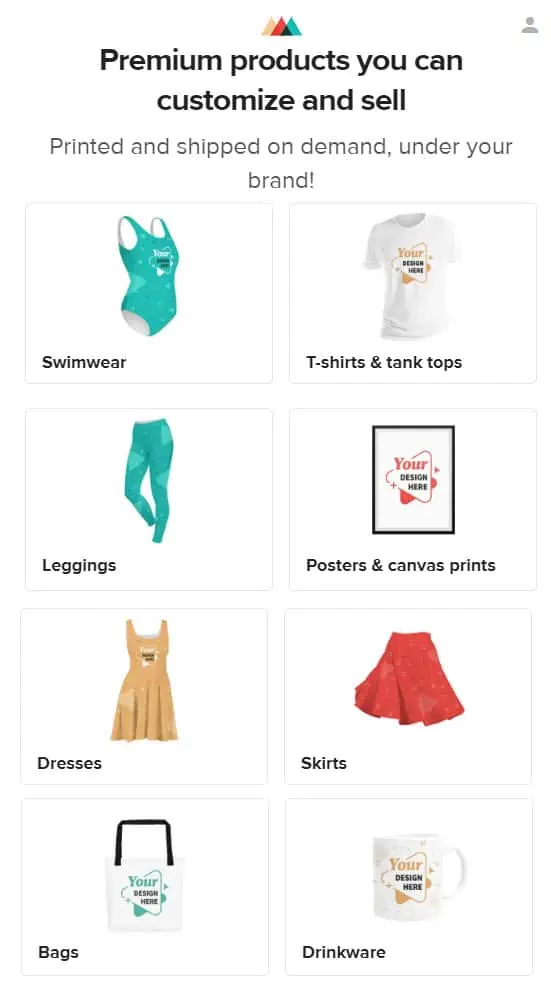
You can also create your own products or partner with a company that manufactures them.
Sponsored Posts
A final way to make money from your review blog is through sponsored posts. Sponsored posts are basically articles that are written by someone else, but they’re published on your blog.
The sponsor pays you to publish their article on your review blog and they usually include a link back to their website.

To get started with sponsored posts, simply reach out to companies in your niche and pitch them an idea for a sponsored post.
If they’re interested, they’ll then pay you to publish the post on your blog.
These are just a few of the ways you can monetize your review blog and make money online.
Remember, it takes time and effort to build up traffic and make money from your blog, so
FAQ
Here are a few frequently asked questions:
What are some good topics for a review blog?
Some good topics for review blogs include travel, food, fashion, beauty, and tech. However, you can really review anything you’re passionate about.
How do I get traffic to my review blog?
There are many ways you can get traffic to your review blog. These include SEO, social media, email marketing, and guest blogging.
How much money can I make from my review blog?
There is no limit to how much money you can make from your review blog. It all depends on how much traffic you can generate and how you monetize your blog.
What are some good affiliate programs for review blogs?
Some good affiliate programs for review blogs include Amazon Associates, Commission Junction, and ShareASale.
What Next?
I hope this guide helped you create a product review blog.
If you have any questions as you set up your new blog, leave a comment below so we can help you out.
In 2024, affiliate marketing will be one of the most popular and lucrative ways to start making money. If you want to get in on the action, now is the time to start a review blog. You now know how to start a successful review blog of your own.
Have you got your review blog up and running yet? What type of review blog are you going to start? Let us know in the comments below.
Share this post with your friends & followers:
